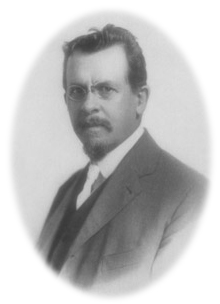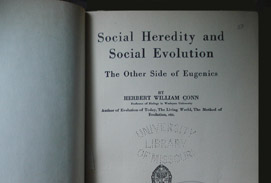August 21, 2009
Between 1907 and 1914, 12 states passed eugenic sterilization laws.
As Paul A. Lombardo details so well in Three Generations, No Imbeciles, enactment of these statutes was driven by a realtively small number of lawmakers, self-promoting policy enthusiasts and a new class of bureaucrats, the directors of institutions for the “feebleminded.” These men, and they were all men, worked diligently and with few expressed doubts to overcome legal and cultural objections to coercive “asexualization” by positioning sterilization of the “socially inadequate” as an hygienic necessity no more violent than immunization.
By 1914, nearly a decade and a half after the rediscovery of Mendel’s work, and at least a year before studies at the Morgan lab and elsewhere challenged the efficacy of any eugenics program, the threat to progress represented by unmanaged reproduction was difficult to dispute.
But the eugenicists’ simple focus on ideal types and individual traits had its challengers.
 After authoring Biology (1912), an innovative college level textbook, microbiologist and Wesleyan professor Herbert William Conn turned his attention to the grander task of subsuming eugenics within a broader and more social evolutionary ideology.
After authoring Biology (1912), an innovative college level textbook, microbiologist and Wesleyan professor Herbert William Conn turned his attention to the grander task of subsuming eugenics within a broader and more social evolutionary ideology.
In Social Heredity and Social Evolution: The Other Side of Eugenics (1914) Conn wrote, “Eugenics is pointing out to us in no unclear light that, whatever may be its social value, the family organization as it exists to-day, at least, in modern civilization, is not adapted for breeding the best type of men.”
Conn, a proud family man, was sure this was wrong.
“This testimony of science,” he wrote, “is another attempt to overthrow the force which has been the guiding principle in civilization” (Conn 144). Natural selection, according to Conn, did not need shoring up, as eugenics suggested, in order for evolutionary progress to continue. Conn suggested that evolution in humans had entered a new phase, one centered not on the individual, but on the family.
Progress according to Conn was driven not by the struggle of individual against individual, but by the struggle between egoism, or an individual’s struggle for survival, and altruism, or the struggle of families to survive.
 Echoing Peter Kropotikin’s critique of Spencerian survival of the fittest-based ideologies, Conn suggested eugenics represented a loss of faith in the evolutionary power of altruism. Since the family, and not the organism, was the unit of selection, individuals could make a positive impact on the evolution of the species regardless of whether they produced offspring or not. He believed that an understanding of social evolution countered the depressing conclusions of science. “[A] result of the recognition of the significance of social heredity is to restore to us the feeling of individual responsibility, which Weismann’s theory of heredity and the discussion of eugenics have tended to destroy” (324).
Echoing Peter Kropotikin’s critique of Spencerian survival of the fittest-based ideologies, Conn suggested eugenics represented a loss of faith in the evolutionary power of altruism. Since the family, and not the organism, was the unit of selection, individuals could make a positive impact on the evolution of the species regardless of whether they produced offspring or not. He believed that an understanding of social evolution countered the depressing conclusions of science. “[A] result of the recognition of the significance of social heredity is to restore to us the feeling of individual responsibility, which Weismann’s theory of heredity and the discussion of eugenics have tended to destroy” (324).
But as critical as he was of eugenics, Conn accepted the frame of progress, as well as the casual racism of his day. From within this paradigm he had to show how his ideas inevitably led to the emergence and maintenance of a superior white race.
Conn accepted the commonly held belief in the Asian origin of his WASP stock. In fact, he framed the struggles of the Aryan race (his label) as it migrated out of Asia, across Europe and on to America in even more heroic terms than “out of Asia” cheerleaders like climatic determinist Ellsworth Huntington (see Civilization and Climate). Speaking of his own ancestors, Conn wrote, “They fought their way. Defeat was annihilation and courage was their only virtue” (167). Unlike Huntington, Conn did not attribute the “progress” of this his race to the vagaries of the weather, but to the tension between the “a tendency toward centralization” and pragmatic individualism. How Conn defined his terms and described this history was quite unique.
Conn claimed that Far Eastern societies, such as China, were patriarchal, while Aryan societies were communistic. While the energy that drove racial progress was, according to Huntington, generated by stormy weather, for Conn, this energy came form the friction of individualism rubbing against a natural tendency toward centralization. Patriarchal societies generated no such friction. Consequently, according to Conn, “[the] patriarchal system produced sluggishness of the people and stagnation of the race.” “Communism,” with its supposed natural resistance to centralization, “made the people restless and produced a race overflowing with activity” (170). Communistic individualism had worked over the centuries in perfect balance to centralization. It was only after the Aryan race fully evolved that the benefits of centralization could be safely and productively embraced. According to Conn, this explained how the societies of the West were in his day advancing so rapidly relative to those of the East. “The fundamental reason for Aryan civilization is that their communal system first developed the man, and when, in recent centuries, centralization made its way into this race, there could arise a society of highly developed individuals” (196)
To advance his ideas, Conn was obliged to challenge the belief that character was biological and largely fixed at birth. He advanced the idea that the social environment was more important to character development. But, having accepted the baseline premises that motivated the eugenicists, that evolution was inevitably progressive, his arguments led to logical contradictions.
Invoking the names of families that would serve as examples for eugenicists of poor and good “stock” for nearly a half century – the Jukes, Kallikaks, and Edwardses – Conn, suggested that a person’s character was not fixed from conception. But he was forced to pull his punches.
If the children of the Jukes or Callicax (sic) families could have been reared in the families of the Edwardses, and the children of the Edwards family reared under the conditions of vice and criminality surrounding the Jukes family, what would have been the result? No one, of course, can answer such a question; but it is safe to say that there would not have been as many criminals in the Jukes family nor as many college presidents or other men of note in the Edwards family (295).
Though Conn states, “no one, of course, can answer such a question,” he did not go so far as to suggest that the difference between the Jukes and Edwardses was entirely environmental. Just two sentences prior Conn wrote, “It is claimed by those who have studied the life of the lower classes that at least three out of every ten criminals might have been saved by simply changing the conditions of their lives” (294).
Environment, it seems, was responsible in Conn’s conception for about one-third of a person’s expressed character. And when Conn moved from questions of class to questions of race, any notion of relativism went completely by the wayside:
The child of the savage, even at birth, is not just the same as the child of the European, and while we must admit that the same individual brought up under different conditions would develop a different type or morality, it is no less true that the raw material out of which the moral nature is developed varies in different races of men (295).
Neatly summing up the ideas of racial hierarchy, recapitulation, and “race children,” key evolutionary concepts associated with Lewis Henry Morgan, Ernst Haeckel, and G. Stanley Hall, Conn wrote:
There is a great difference between the mental process animals and of man; there is an equal difference between the mental processes of the babe and the man who grows from the babe. But just as there is no break between the mind of the child and the adult, so there seems no break between the mental actions of the highly developed animal and the human being (67).
This quote highlights the extent to which Conn embraced the idea that human races were more than just variations within a species, but were in fact separate species (an entirely common view at the time). Though Conn did extend some “relativistic charity” to the lower classes of his own race, the demand for evidence in support his ideas of evolutionary progress drove him to fully embrace Morgan’s cultural hierarchy and hearsay stories of remote “savage” races. It was critical to Conn’s argument that cultural evolution could be shown to have proceeded in a smooth and progressive fashion. This demand drove Conn to strongly promote the idea that the so-called “savage races” represented a link between the lower animals and full-fledged human beings. Conn wrote, “The lowest type of the human family, as exhibited by savages, and hence probably by primitive man, is perhaps only a slight advance over that found among some animals like birds” (148).
Conn’s writings demonstrate just how dependent popular applied evolutionary theories were on myths of progress, and how nearly impossible it was to express a race-neutral or class-neutral critique from within this paradigm.
Herbert William Conn died in 1917.
REFERENCES
Barkan, Elazar. 1992. The Retreat of Scientific Racism: Changing Concepts of Race in Britain and the United States Between the World Wars. Cambridge: Cambridge University Press.
Bowler, Peter J. 1988 (1992). The Non-Darwinian Revolution: Reinterpreting a Historical Myth. Baltimore: The Johns Hopkins University Press.
Conn, Herbert William. 1914. Social Heredity and Social Evolution: The Other Side of Eugenics. New York: The Abingdon Press.
Huntington, Ellsworth. 1912. “Geographical Environment and Japanese Character.”
The Journal of Race Development 2:3.
–. 1914. “The Adaptability of the White Man to Tropical America.”
The Journal of Race Development 5:2.
–. 1915. “A Neglected Factor in Race Development.” The Journal of Race Development 6:2.
–. 1915. Civilization and Climate. New Haven: Yale University Press.
–. 1919. World Power and Evolution. New Haven: Yale University Press.
–. 1925. The Character of Races: As Influenced by Physical Environment, Natural Selection and Historical Development. New York: Charles Scribner’s Sons.
–. 1945 (1962). Mainsprings of Civilization. New York: Mentor Books.
Jacobson, Matthew Frye. 2000. Barbarian Virtues: The United States Encounters Foreign Peoples at Home and Abroad, 1876-1917. New York: Hill and Wang.
Lombardo, Paul A. 2008. Three Generations, No Imbeciles. Baltimore: The Johns Hopkins University Press.

A very interesting article and an even more interesting historical figure. While his clear racial biases speak for themselves, I myself–a “card-carrying” liberal and a “Son of the 1960s/1980s, hippie generation”–asked similar questions about social evolution during my undergraduate study. What is heritable about culture? Language? Mind? Memory? What do the relevant facts, nebulous and indistinct as they are, say about Darwinism, Neo-Darwinism, and Social Darwinism?
I think, if there is to be a “value-neutral” discussion of such a subject, it, possibly, might take place several hundred years from this time. For now, in a world where there are more slaves alive than at any other moment in history (and yet, still, a smaller percentage of the whole population than was true in the past), and, further, in a world that is as full of political invective as our present world is, it is quite possible that there can be no rational understanding–or discussion–of the human animal, his place in nature, and his relation to his fellow sentient beings.
In short, the inability to come to grips with Malthusian realities and the desire, and attempts, to apply Capitalist/market solutions to all problems, real and perceived, will combine to leave humanity in darkness about his/her potential to evolve in non-genetic ways.
For the record, it is my belief that cultural transmission, inheritance, fitness, mutation, gestation/cross-linking, saltations, deleterious mutations, phenotypic expression, and cultural/cognitive selection occur, on par and coincident, though on a different time scale, amongst different individuals (non-familial lines), with genetic evolution. It is my further belief that instant speciation can occur (see G.G. Simpson, the paleontologist/systematist, for a description of the evolutionary species concept, emphasizing “separate and unitary evolutionary role”), though probably, does not, in practice occur (we humans are fairly gregarious creatures, and more often than not, learn each others languages and endeavor to share ideas with each other, precluding maintenance of separate evolutionary roles). So, how many human species are there on Earth? My answer is this; somewhere between 1 species and 6.7 Billion separate species!
This is the dirty secret of the Neo-Darwinian paradigm; it is glaringly inaccurate and incomplete. A mere look at the Hardy-Weinberg equilibrium–arguably the crowning jewel of the Neo-Darwinian achievement–with an eye bent towards cultural evolution, will reveal this fact.
As for H.W. Conn, I will definitely read his book, but not take it too seriously. It will provide some interesting historical knowledge while I move ahead with my study of humanity, his/her folly, faults, and foibles; and perhaps, if I am lucky, I just might gain some insight into his/her promise, ingenuity, and ultimate existential value.
g5j1y5
vckvpv